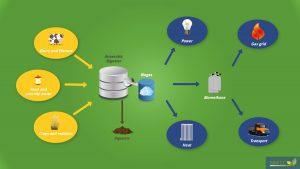Anaerobic Digestion (AD) is a natural process where plant and animal materials (biomass) are broken down by micro-organisms in the absence of air. The AD process begins when biomass is put inside a sealed tank or digester.
Naturally occurring micro-organisms digest the biomass, which releases a methane-rich gas (biogas) that can be used to generate renewable heat and power; this helps cut fossil fuel use and reduce greenhouse gas emissions. The remaining material (digestate) is rich in nutrients, so it can be used as a fertiliser.

Many forms of feedstock are suitable for AD; including food waste, slurry and manure, as well as crops and crop residues. However, woody biomass cannot be used in AD because the micro-organisms can't breakdown the lignin, the compound that gives wood its strength.
AD is not a new technology, it has been used in the UK since the late 1800s, but now an increasing number of AD plants are being built in the UK to generate clean renewable energy. AD is also used to treat the waste produced in homes, farms, supermarkets and industries across the UK. This helps divert waste from landfill.
There are several options for diverting wet organic waste from landfill: home composting; large-scale composting, either in-vessel or windrow; thermophilic aerobic digestion; and AD – a comparison of these options is provided below.
| Approach | Takes all food waste | Takes garden waste | Reduces emissions | Saleable product | Energy Recovery |
| Home composting | - | + | + | - | - |
| Industrial composting | + | + | + | + | - |
| Thermophilic aerobic digestion | + | - | + | + | - |
| Anaerobic digestion | + | - | + | + | + |
AD is the only one of the four options that produces renewable energy as well as recovering the nutrients in the waste in the form of digestate.
The economics of AD are not straightforward as there are many variables. When considering the feedstocks for AD, their cost must be considered against their relative values. For example, slurry may be freely available, crops will incur a cost of production and biowaste may attract a gate fee payable by the supplier as an alternative to disposing to landfill and paying a Landfill Tax.
Organic residues from third parties can attract a gate fee. However, when creating a business plan it is important to remember the value of gate fees can vary significantly. WRAP publish an annual Gate Fees report, comparing gate fees charged for AD with other organic waste treatment, recovery and disposal options.
Visit the AD calculator to calculate the costs, revenue and energy potential of anaerobic digestion.
For information on the funding available to help you set-up AD, see the Funding page and for ongoing support mechanisms, see the Incentives page.
Further Reading
